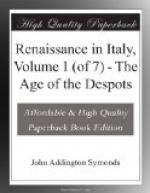a new people, needing concentration to secure their
bare existence. Even during the great days of
ancient Rome they had not been what we are wont to
call a nation, but a confederacy of municipalities
governed and directed by the mistress of the globe.
When Rome passed away, the fragments of the body politic
in Italy, though rudely shaken, retained some portion
of the old vitality that joined them to the past.
It was to the past rather than the future that the
new Italians looked; and even as they lacked initiative
forces in their literature, so in their political
systems they ventured on no fresh beginning.
Though Rome herself was ruined, the shadow of the name
of Rome, the mighty memory of Roman greatness, still
abode with them. Instead of a modern capital
and a modern king, they had an idea for their rallying-point,
a spiritual city for their metropolis. Nor was
there any immediate reason why they should have sacrificed
their local independence in order to obtain the security
afforded by a sovereign. It was not till a later
epoch that Italy learned by bitter experience that
unity at any cost would be acceptable, face to face
with the organized armies of modern Europe. But
when the chance of securing that safeguard was offered
in the Middle Ages, it must have been bought by subjection
to foreigners, by toleration of feudalism, by the extinction
of Roman culture in the laws and customs of barbarians.
Thus it is not too much to say that the Italians themselves
rejected it. Moreover, the problem of unifying
Italy in a monarchy was never so practically simple
as that of forming nations out of the Teutonic tribes.
Not only was the instinct of clanship absent, but
before the year 800 all attempts to establish a monarchical
state were thwarted by the still formidable proximity
of the Greek Empire and by the growing power of ecclesiastical
Rome. We have seen how the Goths erred by submitting-to
the Empire and merging their authority in a declining
organization. We have seen again how the Lombards
erred by adopting Catholic Christianity and thus entangling
themselves in the policy of Papal Rome. Both Goths
and Lombards committed the mistake of sparing the
Eternal City; or it may be more accurate to say that
neither of them were strong enough to lay hands of
violence upon the sacred and mysterious metropolis
and hold it as their seat of monarchy against the
world. So long as Rome remained independent,
neither Ravenna nor Pavia could head a kingdom in the
peninsula. Meanwhile Rome lent her prestige to
the advancement of a spiritual power which, subject
to no dynastic weakness, with the persistent force
of an idea that cannot die, was bent on subjugating
Europe. The Papacy needed Italy as the basis of
its operations, and could not brook a rival that might
reduce the See of S. Peter to the level of an ordinary
bishopric. Rome therefore, generation after generation,
upheld the so-called liberties of Italy against all
comers; and when she summoned the Franks, it was to




